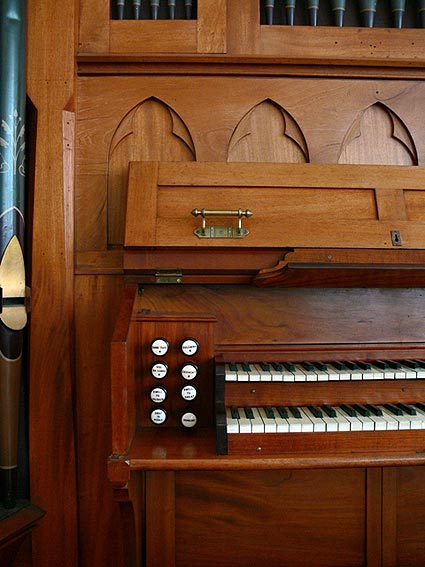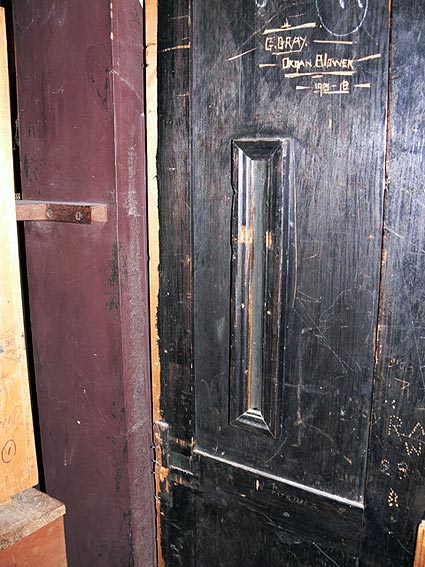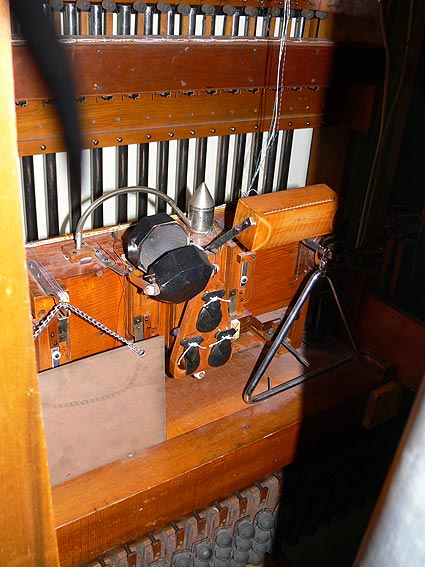The home 'Brightwell' began as the Sacred Heart School, South Heathcote and was built by the Catholic Church in 1910 under the direction of the then Parish Priest, Father Denis J. O'Dee. It opened with lay teachers until 1926 when the Presentation nuns arrived in Heathcote and continued the Catholic education there until 1959. The South Heathcote school was closed and all pupils attended the Holy Rosary School opposite the existing Catholic Church.
From 1959 the building was used as a church until it was sold to Mr & Mrs Glonek in 1973, who built a dwelling beside the church and used the church building as a joinery workshop until the death of Mr Glonek in 1998. It was purchased by Howard and Margaret Terrill at the end of August 1999 and they have restored the building, converting the inside into a comfortable home, but one of open space to enable the historic Alfred Fuller pipe organ to be restored and installed. A chamber was later built on the south side of the building to accommodate the Wurlitzer pipe organ from Sydney.1
The older pipe organ installed at 'Brightwell' came from the Mackenzie Street Uniting Church in Bendigo. It was installed in this former Methodist Church in October 1900 and used continuously until the church closed its doors in 1997. The instrument was removed from the church building on 2 March 1999 by Wakeley Pipe Organs.
The instrument was built by Alfred Fuller, of Kew, Melbourne, who sold it to the church after having built it in his workshop between 1897 and 1900. A card found in the swell windchest had the inscription 'Alfred Fuller and Son / 29/9/97 Kew / Melbourne'.2 In the dismantling process it was evident that the great soundboard and pipework were much older than the swell soundboard, pipework, console and action. Investigations revealed that Fuller traded in a pipe organ and installed a new one at St John's Anglican Church, Heidelberg that was opened on 8 January 1896. The Great soundboard is most likely from the earlier organ at Heidelberg. George Fincham described this organ in 1879 as a single manual instrument with four stops: Open Diapason metal 44 pipes, Stopped Diapason wood 56 pipes, Principal 4 56 pipes, Fifteenth 2 56 pipes, enclosed in mahogany case with gilt speaking pipes in front.3 The origins of this instrument date back to a three-cylinder rotating barrel organ installed in the church in 1852 and rebuilt by Fincham in 1873 who installed a keyboard with action and extra pipes.4
The minutes of the Mackenzie Street Methodist Church of 15 August 1900 state:
"That we obtain the Pipe Organ offered by A. Fuller, if he will take the £150 and alter the Cornopean stop to some other, say Gamba or Keraulophon. N.B. This is to be erected in the Church complete for the amount stated."5
As an historical aside, the minutes of 20 January 1901 state: "That the Organ Blower be paid 6/6d per quarter."
To the older nucleus, Fuller extended the case laterally and provided two five-pipe towers at floor level. Additional case posts and a distinctive frieze of Gothic arches above the console were supplied, the latter closed by a folding lid. The lateral towers are very much a signature of his work and three other examples may be found in the organs he built for St Mary's Catholic Church, Echuca 1890 (now at St John's Catholic Church, Heidelberg), St John's Anglican Church, Heidelberg 1896 (rebuilt and altered in the 1960s) and Scots Presbyterian Church, Fremantle 1897. The action, console, wind system and swell box are Fuller's work. A characteristic feature of his work is the two wind indicators enclosed within glass panels, one at the console and a second at the rear of the organ, for the blower.
This was the last organ to come from Fuller's Kew workshop before he retired from organbuilding and went into real estate with his son. He died on 10 June 1923 and left an estate valued at £15,154/6/11, a very considerable sum for the time.6
The restoration work by Wakeley Pipe Organs Pty Ltd, of Lilydale, Victoria (in accordance with the OHTA Pipe Organ Conservation & Maintenance Guide) has involved the repairing of the great soundboard and the cabinet work; the pipework has been attended to and regulated where necessary.
A citation from the National Trust of Australia (Victoria) reads:
"A two-manual organ of nine speaking stops built by Alfred Fuller, of Kew, believed to date from the end of Fuller's organbuilding career about 1900. The instrument retains its original action, console and pipework and is a rare intact example of its builder's work and of note for its diminutive size."
The specification follows:
GREAT ORGAN
Open Diapason
Stop Diapason
Principal
Fifteenth
Swell to Great
SWELL ORGAN
Gedact
Viol da Gamba
Dulciana
Suabe Flute
Tremulant
PEDAL ORGAN
Bourdon
Great to Pedal
Swell to Pedal
|
8
8
4
2
8
8
8
4
16
|
gvd bass
gvd bass
(added later)
|
Compass: 56/30
Lever swell pedal
2 composition pedals to Great
Mechanical key and stop action
Attached drawknob console
Hand blowing
Wind indicators set in glass boxes at console and at rear7
1. Howard Terrill, "Relocated organs : 'Brightwell, Heathcote, Victoria'", OHTA News, vol. 23, no. 3 (July 2000), pp. 3-4
2. Inscription noted by Ian Wakeley
3. George Fincham & Sons letter books 3/98, to Revd Rockfort Forlong
4. E.N. Matthews, "Old Barrel Organ", The Age, 31 July 1965
5. Noted by Howard Terrill
6. See: "Alfred Fuller", OHTA News, vol.31, no.3 (July 2007), p.3
7. Specification noted John Maidment 1966, 2008

Photo: Simon Colvin
The second organ at "Brightwell" was built in 1928 by The Rudolph Wurlitzer Company, Cincinnati, Chicago and New York (model H) opus 1868 for Kings Cross Theatre, Kings Cross, NSW. In 1937 it was moved to the Savoy Theatre, Hurstville, NSW reputedly by Hill, Norman & Beard (Australia) although this is not listed in the firm's order books. It was moved again in 1958 to the Congregational (later Uniting) Church, Burwood, NSW. It was replaced there in 1992 by an 1887 Gray & Davison organ installed from a redundant church in Wales. The Wurlitzer instrument was removed, fully renovated and installed at Heathcote in 2002-3 by Wakeley Pipe Organs.
The instrument has two manuals, 12 extended ranks and electro-pneumatic action. The ranks include:
Harmonic Tuba
Trumpet
Diaphonic Diapason
Tibia Clausa
Clarinet
Kinura
Orchestral Oboe
Violin
Violin Celeste
Concert Flute
Vox Humana (Solo chamber)
Vox Humana (Accompaniment chamber)
Percussions include:
Bass drum
Kettle drum
Crash cymbal
Tap cymbal
Snare dum
Tambourine
Castanets
Sleigh bells
Chimes
Xylophone
Glockenspiel
Chrysoglott
Piano1
1. Details noted John Maidment March 2008
Photos: JRM (March 2008)

























